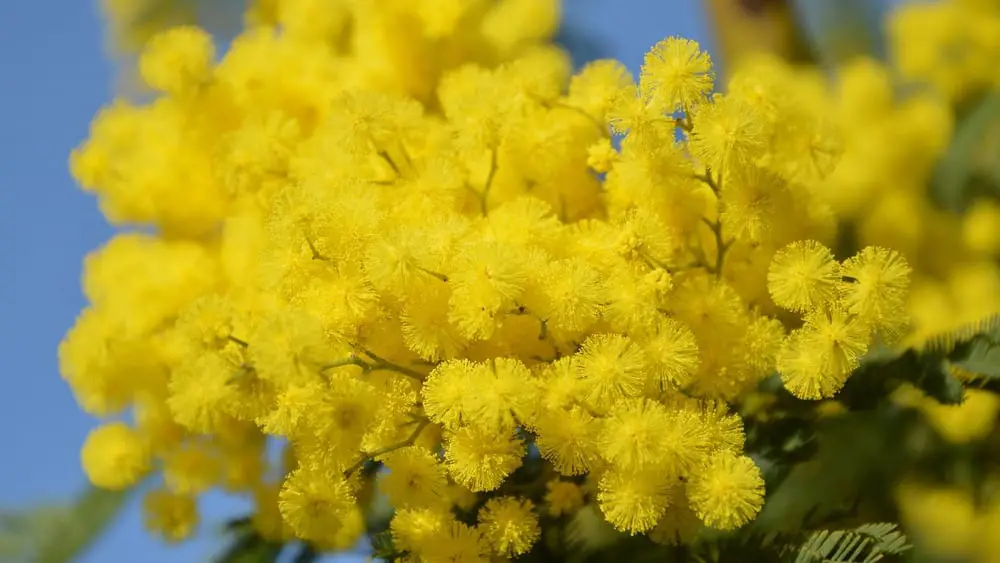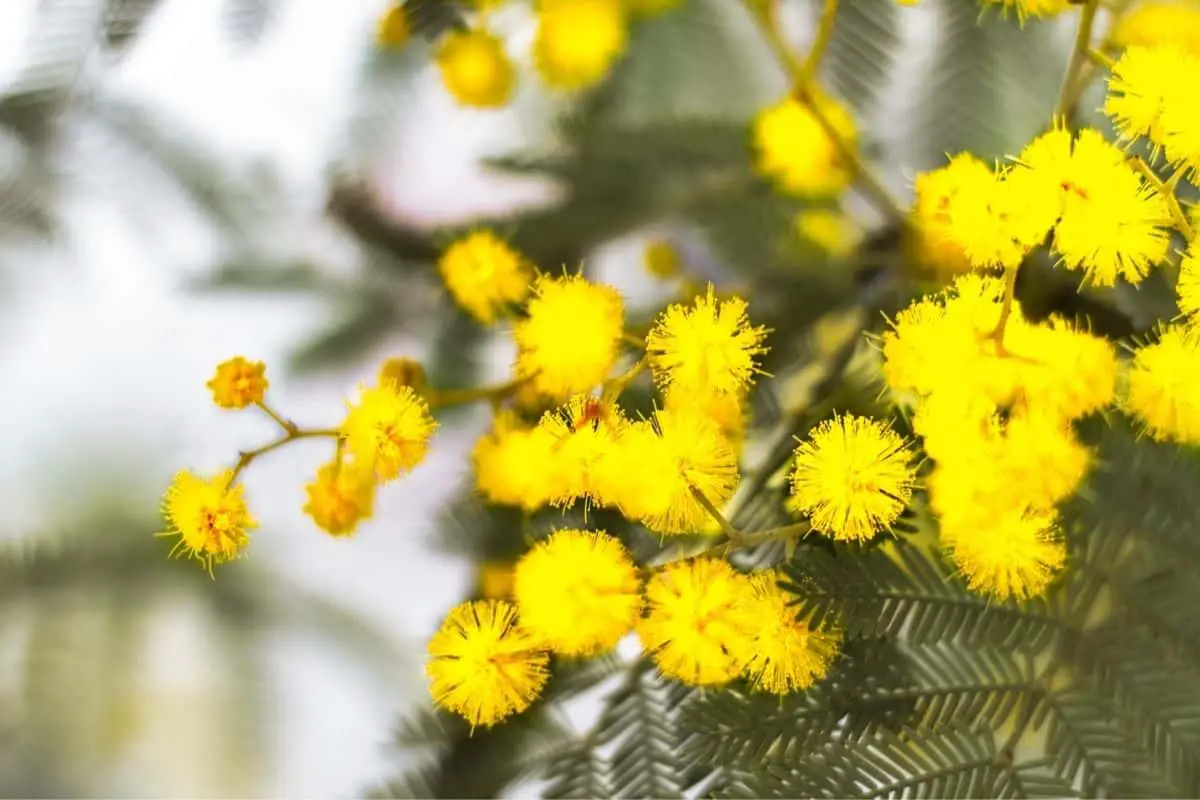You must be thinking that this Mimosa is something you would order from a fancy cocktail bar, but this is definitely more than just a classy drink! Its small pom pom-like flowers come in many clusters that are also a favorite in gardens and yards. Just like the fancy drink, its colors are just as bright and bubbly. But don’t let this fool you since it is actually also a weed!
The mimosa meaning and symbolism is heavily influenced by its rich history and floral colors. It also has multiple uses such as an ornamental plant and a traditional medicine. It comes in colors such as white and yellow which means sensitivity and cheerfulness. The flowers also bloom in pink and purple which symbolizes independence and delicate feelings. The most beautiful color this flower comes in is red which represents a secret love.
History of Mimosa Flowers
The Mimosas were first mentioned in 1731 as a beautiful tree or shrub with small round flowers and prickly leaves. They are annuals or perennials native to the tropical or subtropical regions of the hemisphere. The flower is a genus plant from the genus Mimosa of the pea/legume or Fabaceae family.
This prolific bloom name has a cute reason for it. Mimosa derives from the Latin words mimus meaning mime and osa meaning feminine. It also takes after the Greek word mimos which means actor or mime. German botanist Wilhelm Pfeffer was the first to discover the flower during his tests for plant habituation. Aside from its Latin name, this flower is very well known for how its leaves mimic sudden animal sensitivity.
Here’s some interesting facts about the mimosa. Its name is sometimes confused with other different shrubs and herbs such as the Silver wattle (Acacia dealbata) which is also from the legume family. Apart from its increased sensitivity, it prefers warmer climates but can grow almost anywhere around the world.
It comes in many names such as sensitive plant, sleepy plant, or action plant. Some of the most common species of this genus include the ever-famous Sensitive plant (Mimosa pudica), Wait-a-minute bust (Mimosa aculeaticarpa), Black jurema (Mimosa tenuiflora) and Elegant Mimosa (Mimosa arenosa).
Symbolism of Mimosa Blooms
The works of Mercé Rodoreda bring to life the symbolism of Mimosas. As told in the tale, the mimosa represents the shyness of a young maiden in love with a mighty soldier.
This floral motif is a symbol of cheerfulness and independence – an important figure during women’s day. In fact, the lands of Australia and South Africa honor these prickly flowers as floral emblems! In other cultures, the flower is tied to sensitivity or being emotional and is viewed as a gesture of mourning.
Turning to astrological beliefs, readings, and other messaging, the blossoms are said to be the floral embodiments of the zodiac signs Capricorn, Aquarius, and Sagittarius.

Meaning of Mimosa Florets
The closest meaning of the mimosa is related to how its leaves mimic conscious life and not just the cute flowers that bloom. Some of these meanings include sensitivity and shyness or bashfulness which are actually from the way the leaves close themselves up when touched! Really something out of the ordinary.
What does a White Mimosa Flower Mean?
White Mimosas bear the meaning of sensitivity and attentiveness. This meaning is associated with the mimicry of how the leaves fold upon a trigger.
What does a Red Mimosa Blossom Symbolize?
Mimosas with red petals are symbolic of secret love and being nervous. Just like the shyness of the leaves when touched, who wouldn’t act that way with their first love, right?
What does a Pink Mimosa Floret Represent?
A representation of vitality and beauty out of the ordinary is what pink petaled Mimosas stand out for. It beholds not exquisiteness from its flowers but also independence.
What does a Purple Mimosa Bloom Indicate?
Apart from symbolizing sensitivity or shyness, purple Mimosas indicate one’s delicate feelings. With how the flowers appear, who wouldn’t say a purple one isn’t delicate!
What does a Yellow Mimosa Flower Symbolize?
Mimosas come in bright yellow colors that are just as exciting as the cocktail mix! In fact, these yellow flowers represent symbolic poetry and other messaging. It also symbolizes cheerfulness through the bright yellow petals and blessings of good luck with the abundance of its floral clusters.

What is the Cultural Significance of a Mimosa Flower?
A small quaint town in Montenegro celebrates the beauty of these flowers every February. In Herceg Novi, the town is transformed yearly with colorful flowers and decorations for the Mimosa festival. The flowers in this town are believed to be the heralds of Spring signaling the end of Winter.
According to the legend told in India, the flowers were said to have fallen from a falcon’s claw and feather. It fell onto the ground and bloomed into what is now known as the Indian thorn tree (Mimosa catechu).
In some European countries, the mimosa holds a special importance even during World War II. Specifically in Italy, the flowers were the official flower that symbolize International Women’s Day every March 8th. It stood as the floral relic of the first women’s union during the start of women’s day.
During the same day, Russian women and Jewish immigrant women from other cultures also honor these amazing flowers during the celebration and wherein giving mimosa flowers to other women across the country are a life-giving symbol of a goddess or hero. Looking back, this tradition dates back to the offertory practice in the temple of Isis in Egypt and the temple Solomon.
What is the Biblical Meaning of a Mimosa Tree?
In Christian beliefs, the Mimosas symbolized the certainty of Christ’s Resurrection. The flower’s bright yellow color symbolized the rising sun while its leaves mimicked the sentient of life.
A Coptic legend also believes in the Mimosa’s symbolic association with Christ. The legend says that the tree or shrub flower’s mimicry effects reflect the first worship to God. It was a symbol of significant spiritual boost. The collective happiness bark was used as a helpful tonic to guide one to better energetic pathways in life.
What does a Mimosa Floral Tattoo Symbolize?
These flowers are a known symbol for the ladies during women’s day. The choice of Mimosas for a floral tattoo design is very uncommon unlike most florals out there. This floral tattoo design embodies one’s shyness and delicacy. Appearing just as meek as the flowers, it also represents your grace and elegance.
Uses of the Mimosa Plant
These flowers are actually considered a very invasive species with how fast they can multiply aside from its popular symbolism of women’s day. It is frequently used as a garden ornament tree or shrub with a mimosa bud blooming into pretty little flowers in Spring.
Unlike other blossoms, Mimosas cannot be consumed in any manner because of the prickly thorns it has. It would be surprising to you if you found out that these flowers can be more than just ornaments since it has traditionally been used as medicine for some ailments.
Mimosas according to traditional Chinese medicine are known to have antibacterial, antivenom, antifertility, and antidepressant properties. It was claimed to be a homeopathic medicine that can help to treat coughs and other inflammatory conditions. This is the reason why several countries such as the Philippines, India, Thailand, Vietnam, and many others use it in such a way. For the Thai-Lanna people in Northern Thailand and the ancient Mayans, the flower can be used to treat burns, diabetes mellitus and insomnia.
The folk in Fiji also practices the use of these flowers to treat fever, leprosy, insect bites, and hemorrhoids. In the Philippines, it is mixed with coconut oil to treat common wounds and ulcers. The most surprising use of this flower can be found in New Britain and Papua New Guinea.
Who knew that this plant’s roots and leaves can be used to treat swollen testicles? That is the common traditional remedy for the folk there! A word of warning that it’s a must to always consult a medical professional before using this plant or any part of it for medical purposes.

